Andrew McLuhan at his parent’s barn/workshop, photo by Lindsay Duncan
By Isabel Slone
Every time I tell someone that I grew up in Prince Edward County, their eyes glaze over and they quietly murmur: “That must have been nice.” Maybe they’re imagining a bucolic rural childhood running through grassy fields, unencumbered by the urban dangers of traffic, noise, and child predators. Or perhaps they’re envisioning endless rows of luscious grapes to be crushed into wine, folksy bed-and-break- fasts run by crinkly-eyed matrons and sandy beaches overlooking cool, clear Lake Ontario. But what I remember as an isolated place full of boredom and teenage pregnancy has transformed into a thriving arts community where the low cost of living and abundance of space allows the DIY spirit to roam free. The scenic wine-soaked pastures of the County are increasingly becoming home to a ramshackle community of printmakers, zinesters, punk rockers and independent artists.
In the past decade, the County has gone through a complete image transformation: from economically-depressed farming area to world-class tourist destination. When the wine industry cropped up in the mid 2000s, it was originally poised as the perfect getaway for gourmands and adherents of the Hundred Mile Diet. But Prince Edward County is not just a pastoral place where yuppies and locavores can frolic in unencumbered glory. Its reputation has since expanded into an artist’s paradise; where just about anyone can buy an old barn and convert it into a gallery, or spend a month working on their novel in the A-frame cottage that used to belong to poet Al Purdy.
“You can divide the history of the County into pre-wine and post-wine,” says Andrew McLuhan, a longtime County resident and local creative. “The County has a history of being in the spotlight and going back into obscurity. Back in the 1920s and ‘30s it was really ripping and roaring. Then during the Great Depression it quieted down for several years.”
Prince Edward County is not where you’d expect Canadian intellectual royalty to be hiding out, but Andrew McLuhan — grandson of media theorist Marshall McLuhan — has lived in the County since 1996, when his parents uprooted him from their home in the Beach in Toronto to Wellington, ON after seeing an ad for a church for sale in the Toronto Star (they bought it). McLuhan’s day job is running the one-man furniture upholstery business, The Cover-Up.
In his spare time, he’s the definition of creative multi-hyphenate, writing violent speculative fiction (The Mutant Beavers of Delhi is about “beavers that are genetically mutated and become addicted to drugs and junk food and attack people”), working as a projectionist at the County’s Regent Theatre, and dabbling around in music. His current project is a reggae-inspired band with a few friends tentatively titled the FADs — the Freakin’ Awesome Dads.
Like a lot of people with famous relatives, the young McLuhan found his grandfather’s reputation to be more of an irritation than a bragging point. “As a normal rebellious teenager, I started to resent people asking about my grandfather,” he says. “I’d tell them, ‘What do I know about that stu ? Go read a book.’” Then he discovered punk. He started writing a zine to disseminate his thoughts — “I conned the principal into letting me use the photocopiers to do it” — and helped found the now-defunct punk band The Polidicks, whose songs include “Money Grubbing Motherfucker” and “Kill Dr. Phil.”
It may seem like McLuhan’s decision to work with his hands is a rebellion against the family trade of academia, but the truth is much more pragmatic. As a teenager, he needed a job and his neighbour, an upholsterer, happened to be looking for an assistant. He learned the trade, taught himself to sew and the rest is history. Affordable housing prices — McLuhan owns a house in nearby Picton — and a comfortable workshop setup on his parent’s property means that he can a ord to pursue his passions while also owning a home and raising a young family — something that would likely not be possible for an artist living in a bigger city.
When illustrator Carl Wiens moved to the County from Toronto in 1998, it was a “backwater.” “The economy had basically stalled out and there wasn’t much going on,” he says. But around 2010, he noticed a dramatic shift as the County zoomed from sleepy rural region to bustling, vibrant community. “It felt sudden, not gradual at all.” Since then, the County has been dubbed one of the 50 best places in the world by TIME Magazine, Paris Vogue named the Drake Devonshire — an outpost of Toronto’s hip Drake hotel that set up shop in Wellington in 2014 — a hotel hotspot and it’s been featured as a top destination to visit in Harper’s Bazaar, The Independent and Condé Nast Traveller. “To an extent, you can think of Prince Edward County as the latest gentrifed neighbourhood of Toronto,” says McLuhan.
Tess Girard, a filmmaker, moved to the County in 2012. “The Drake followed us,” she laughs. Her and her partner Ryan Noth moved to the County because it has “all the lovely little things that rural Ontario can offer but all compacted into one area.” They liked the idea that there were art galleries they could visit regularly, and the two- hour drive to Toronto wasn’t too demanding. But the real draw was the housing prices — the average home in the County sells for around $250,000 compared to the astronomical $1 million in Toronto. Since their move four years ago, people have gone from asking them, “Why are you moving there?” to “How do I move there?”
On the last Wednesday of every month, a crowd of zinesters cram into the Acoustic Grill in Picton to drink, talk, and draw at the monthly Prince Edward County Comix Jam. Any and all skill levels are welcome and everyone is there to express themselves on pen and paper. “We produce anything from this fantastic drawing to a poop joke,” says regular attendee Tim Snyder.
The Comix Jam was created by County native Niall Eccles based on similar ones he attended during his time living in Montreal. Eccles has been instrumental in creating the vibrant community that the County is now renowned for. In addition to the Comix Jam, he also runs zine making workshops at the County Author’s Festival, founded a DIY comics zine called Marmalade, and donated most of his graphic novel collection to get a comic book library up and running at the Picton Library. He’s genuinely excited about what is happening in his hometown, and animatedly gives me a plethora of examples: an arts-focused radio show hosted by stained glass artist Vanessa Pandos, the Baxter Centre, a building in Bloom eld that hosts silent movie nights and other creative endeavors, and a new alternative movie night at Picton’s Regent Theatre.
To Eccles, inclusivity is cornerstone of the new arts community he’s helping to foster. He says the supposedly imminent class war between the County’s stalwart farmers and incoming city slickers is completely fabricated. “It’s more integrated than the articles will have you believe,” he says. “I can’t encourage what I consider to be false divisions. County vs. city doesn’t exist.”
Mile Murtanovski, a painter who runs the artist’s residency Small Pond Arts with his wife Krista, echoes the sentiment: “A place like the Drake will come in and impose their urban sensibilities, whereas we wanted to weave into the tapestry of Prince Edward County,” he says. Since moving to the County in 2006, Murtanovski has made a strong effort to integrate with the community, organizing free events during the tourist season such as the Firelight Lantern Festival, a magical parade of mammalian lanterns that helps banish the encroaching winter darkness.
Bike life in the PEC. Photo by Mile Murtanovski
But for all this talk of inclusivity, it’s enormously troubling that the majority of incoming migrants to the area are a) white and b) have enough money in the bank to purchase property. While reporting for this article, I was able to locate only one artist of colour: Johnny Lam, a photographer who was born in Hong Kong and moved to the County in 2011. Altogether, the demographics of the County haven’t shifted much since I attended elementary school; at Kente Public School in Ameliasburgh from 1996 to 2003, I didn’t encounter a single non-white classmate. This begs the question: how vibrant can a community really be if it’s only attracting one type of person? Everyone I spoke with seemed hopeful that the lack of diversity is a challenge they could tackle, but remained woefully devoid of ideas on how to do it.
Encroaching on the parking lot of Sobeys in downtown Picton is a dilapidated structure that has been abandoned for the better part of a decade. Once a grand old house, the exterior paint is peeling and the shingles are beginning to crumble with age. But its seemingly advanced state of decay belies the property’s status as a brand-new community hub. The House of Falconer, as it is now called, was quietly purchased by County restaurateur Alex Fida in 2015, who has renovated the space into a bohemian artist’s hangout that bears traces of its former glory, like filigree wallpaper and ornamental ceilings.
One morning in late April, the doors are open to the public for the Marm Art Fair, where a selection of County creatives have come to hawk their wares. There’s McLuhan, sitting behind a table stacked high with copies of The Mutant Beavers of Delhi; Eccles flits around from room to room, greeting the guests while selling copies of Marmalade. Upstairs, the artist Zac Kenny is giving tours of his painting studio. Kenny is renting the space from Fida all summer in exchange for a few of his paintings. After Kenny’s residency is over, his studio will be replaced by a flash tattoo shop. In contrast to the manufactured chic of places like the Drake Devonshire, the Marm Art Fair provides a window into the world of these rural creatives, who band together while practicing their craft to build an authentic sense of community and collaboration.
Surprisingly, most of the people who live and practice their art in Prince Edward County are fairly indifferent to the sheen of new money and leisure infiltrating their hometown. Since moving away pre-hype in 2008, I find the sudden spotlight on my childhood home more irritating than flattering. After spending the first two decades of my life there, I feel an indirect sense of ownership over the place and my hackles raise whenever I read about it in a light that conflicts with my own experience of living there. “It’s boring! You don’t want to go there!” my insides scream whenever the latest puff piece hits the newsstands. And yet for the folks who are actually building the community, it doesn’t seem to bother them one bit. They’re not worried about encroaching gentrification and aren’t even particularly jaded by the cottagers who invade the County on weekends, flooding the beach and creating traffic on the usually free-flowing highways. “The more people who know about [Prince Edward County] the better,” says Eccles. “It doesn’t matter if they’re visiting for the week or they’ve lived there for 30 years.”
Isabel Slone gratefully acknowledges the support of the Ontario Arts Council’s Writer’s Reserve Program.


